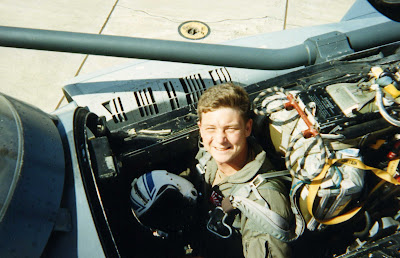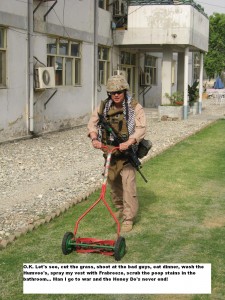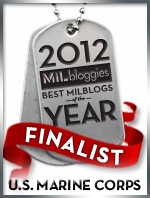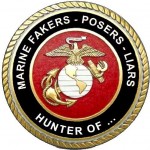Legends
December 17th, 2007 Posted in The SandGram v1.0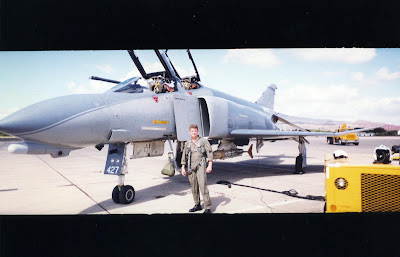
The sign of a great pilot is that he won’t tell you how great he is. Back in Dec of 1992, the FDO (flight duty officer) called me up and asked if I wanted to fly to Hawaii to pick up a refueling job for a week. What a dream trip, one week in Waikiki and all we had to do was refuel two F-4 Phantoms on Tuesday and Thursday. Since the trip was leaving December 4th, it went to all of the single guys who didn’t care if the plane broke there and missed Christmas since it was a two week deal. The flight over was a blast as we talked about what we planned on doing while staying at the OutRigger hotel on the beach.
Well, I’m a firm believer in that the answer is no unless you ask, so I just had to ask. The F-4 was out of service for the military, especially the Marines, so the opportunity to get a backseat hop was just too great to pass up. On Tuesday, we took off with a full bag of gas and climbed up to twenty-five thousand feet. I was flying in the right seat, “Paulie” was in the left seat with “Hairy Larry” standing over my shoulder. The two jets joined up with us over Barking Sands missile range near the island of Kauai. Dick was in a blue F-4 and his partner was flying the white one. Both pilots were retired Air Force Col’s who had spent many hours in the front seat of this jet, bombing the crap out of the VC during Vietnam. They handled their jets with fingertip finesse, plugging into our baskets with ease. After Dick topped off on his gas, he flew under the right wing of our KC-130 and pulled up right next to our plane. We were all a bit freaked out by this show of airmanship but he was planted right there, not moving. Perfect formation flying. When “Paulie” asked him if he could move a bit closer (being factitious of course), Dick chuckled and said “You guys haven’t seen anything yet, man I wish I could show what we did to the Russian Bears we intercepted in Alaska.” Then he toggled the mike and said “Hey Taco is that you?” Of course, I replied to the man I could touch next to me. He then asked “I thought you wanted to go fly with us, what happened?” man I was all over him with questions about going up and he just told me to show up on Thursday two hours prior to the brief and bring another Marine along for a ride on the hop that day. I was ecstatic at the chance to go up with him. Since I flew on Tuesday, ole “Hairy Larry” had to go fly on Thursday and wouldn’t be able to go. Now it was down to a couple of the enlisted guys in the back as to who wanted to go.
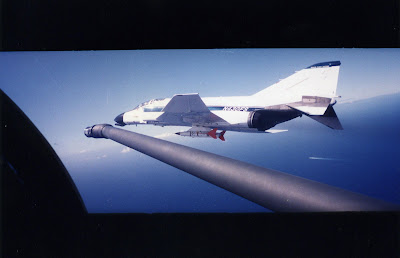
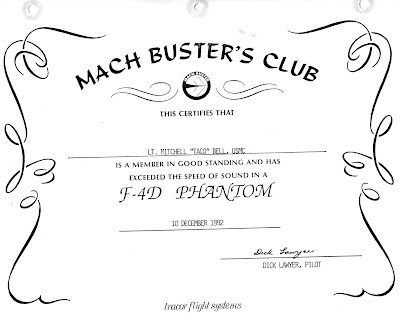
As it turns out, I googled “Dick Lawyer pilot” and found out that Dick had passed away. What I read though was incredible. Here is his obit, what a man. As I drink a glass of red wine with my dinner tonight, I will toast Dick, a great American and so humble that you would never know it.
Semper Fi,
Taco
Former test pilot, astronaut-select and flight instructor Richard Lawyer, 73, died November 12, 2005, at his home in Palmdale, Californi
a, of a suspected blood clot.
Lawyer had assured her years ago he would walk away from airplanes at the very first indication that his flying was not up to his high standards, she said, a promise he thankfully never had to fulfill. Lawyer was in the cockpit three days before his death and was scheduled to fly for the test pilot school November 14, 2005.
He was a distinguished graduate of the Air Force Fighter Weapons School and of the Air Force Aerospace Research Pilot School (now the Air Force Test Pilot School at Edwards Air Force Base).
His Air Force career included two combat tours during the Vietnam War, as well as a time as chief of fighters at Edwards.
One little-known facet of Lawyer’s career was his selection in 1965 as one of the first astronauts to the Air Force’s classified Manned Orbiting Laboratory program. This program, later canceled without sending any astronauts into space, was to man a military space station with Air Force astronauts using a modified Gemini spacecraft.
Even after the program was canceled, Lawyer did not discuss it, still feeling the obligation to honor its secrecy.
“They made a vow; they never were released from that,” Gayle said. “That was huge. He was a man of honor.”
After his Air Force retirement in 1982, Lawyer served as flight test manager for Martin Marietta (now Lockheed Martin Corp.) at Edwards.
He then went on to join the National Test Pilot School and later another Mojave Airport business, Flight Systems Inc. There, he served as chief test pilot, piloting the first flight of the QF-4 drone.
Lawyer retired from Flight Systems in 1998 but continued at the test pilot school and as a self-employed consultant and test pilot. He most recently flew the F-100 for Flight Test Associates’ tests of Northrop Grumman Corp.’s Guardian airliner defense system.
Lawyer was a fixture at the Mojave Airport, known for driving his truck around the airport to visit friends after work at the test pilot school.
“Dick Lawyer has known a lot of big names in aviation history,” said friend and Mojave Airport tenant Cathy Hansen . “He was a big name himself, but he just didn’t know it.”
“He was very humble, quiet and soft-spoken,” she said. “He had a dry sense of humor which I thought was just hilarious.”
Hansen’s husband, Al, credits his license to fly his F-86 jet to Lawyer’s cockpit checkout.
“Dick was one of two people Al let fly” the F-86, she said.
In addition to flying, Lawyer had a passion for hunting and fishing, his other life-long love.
“When the day came flying was over, he was going to do even more hunting and fishing,” Gayle said.
Lawyer had just returned from an elk-hunting trip to Colorado when he died. He had also already begun planning his annual Alaskan fishing trip.
His other great joy – one he found unexpectedly later in life – was his nine grandchildren, ages 18 months to 11 years old.
“He adored his grandchildren,” Gayle said, introducing the older ones to fishing and flying. They were a “joy in his life he knew would be there when the day came that he might no longer be able to do the things that filled his life with joy.”
In addition to Gayle and the nine grandchildren, Lawyer is survived by sons Tim Lawyer of San Luis Obispo and James Lawyer of College Station, Texas; daughter Lisa Burr of Austin, Texas; stepdaughters Casey Hinds of Lexington, Ky., and Halya Mugglebee of Sherman Oaks.
“He was very much a family guy,” Cathy Hansen said.
Cathy sent Lawyer an e-mail, apparently one of the last he read, that talked about living life to the fullest.
“He had. He was living proof of that,” she said.
Lawyer will be remembered by family and friends in a memorial service at the National Test Pilot School on Dec. 17. For aviators like Lawyer, the date holds special significance as the anniversary of the Wright brothers’ first flight.
He will also be paid tribute with full military honors in a burial at Arlington National Cemetery on January 5, 2006.
It was Lawyer’s wish that, in lieu of flowers, donations be made to the Society of Experimental Test Pilots Scholarship Foundation or to the Air Warrior Courage Foundation of the Red River Valley Fighter Pilots Association.
Colonel Richard E. Lawyer, United States Air Force, was born on 8 November 1932 in Los Angeles, California; he is married with three children. He received a bachelor of science degree in aeronautical engineering from the University of California in 1955 and was chosen for the MOL (Manned Orbiting Laboratory) programm on 12 November 1965 (Group 1).
Following the cancellation of the MOL programme he remained with the Air Force and returned to active flight duty. He is currently Deputy Commander, Test Evaluation Directorate, Air Weapons Center, Tyndall Air Force Base, Florida.
Richard E. Lawyer, 73, passed away on November 12, 2005, the day after Veteran’s Day. The apparent cause of his death was a deep vein blood clot. His death was peaceful but completely unexpected; he was sitting at his desk at home. Dick Lawyer was born November 8, 1932 in Los Angeles and served his country as a test pilot, as a designated astronaut who never flew in space due to circumstances beyond his control, and as a senior officer in the Air Force.
The retired Air Force Colonel still taught at the National Test Pilot School at the Civilian Flight Test Center in Mojave, California, still conducted flight tests, and was scheduled to fly this week, according to the Society of Experimental Test Pilots.
Lawyer remained healthy and active, holding a Class 1 medical certificate till the day he died. Indeed, the F-100F pictures, taken earlier in 2005, show Col. Lawyer (below, front seat, blue helmet) and a flight test engineer conducting calibration test flights at Mojave earlier this year. The purpose was to get valid data up to Mach 0.90 in support of a Boeing 737 flight test program, so the intrepid duo passed by the Mojave tower at 70 feet AGL at speeds up to M0.90 which is 560 kts. Not many septuagenarians are doing that, but then, there was only one Dick Lawyer.
Colonel Lawyer first came to the attention of Aero-News in June, when we ran an article on the discovery of a spacesuit with his name on it at Cape Canaveral. His relatives sent him that article, which upset him, because it mentioned that we tracked him down to the NTPS and they didn’t respond to our email (it turns out we used an old address that isn’t monitored). That article is here. (“NASA Finds 1960s Spacesuits,” 17 June 05). He was upset at the idea that people would think him unresponsive, which illustrates a little something of his character — the humble, friendly test pilot — not exactly a stereotype.
When he did get in touch with us, he was very complimentary about the article, and a little bit bemused that anyone even cared about the Manned Orbiting Laborat
ory, forty years later. “While it contains a few minor errors, is the most accurate and detailed article of all those that have appeared,” he said. To us, that comment was worth more than a Pulitzer Prize.
The Manned Orbiting Laboratory, announced in 1963, had some of the features of a space station. A crew of two would launch in a modified Gemini capsule, the Gemini-B, and on reaching the desired orbit, would be able to go through a hatch in the back of the Gemini into the MOL’s work and accommodation spaces.
After spending thirty days in space, the crew would climb back into the Gemini-B capsule and deorbit. At a relatively low altitude, under 100 miles, the orbit of the MOL would decay and it would soon be destroyed by re-entry.
Then-Captain Richard E. Lawyer was selected for the MOL in its first group of pilots — they avoided the word, “Astronaut” — selected. That group was announced on November 12, 1965 — forty years to the day before Lawyer would pass away. The original MOL pilots were all USAF Test Pilot School or Naval Test Pilot School graduates. Lawyer mentioned to us with some pride that he graduated the USAF TPS, but he — characteristically — never got around to mentioning that he was distinguished graduate of his class, we had to learn that elsewhere. It probably helped him that he started his Air Force career with an Aero Engineering degree from USC — but he never mentioned that to us, either.
When the program was cancelled, officers under 35 years old were permitted to sign on as NASA astronauts. All did, and all went on to fly in the Shuttle program — one went on to be NASA Administrator. But then-Major Dick Lawyer was a few months too old. He, like the other “overage” pilots (except for one who took a non-astronaut position with NASA), returned to the USAF where he served in numerous assignments with distinction before retiring in the early 1980s as a Colonel. His last assignment was deputy commander of Eglin Air Force Base, at the time a significant test center.
Characteristically, Colonel Lawyer expressed no bitterness at the cancellation of the MOL, or the bureaucratic rule that would have let him go into NASA had he only been born in 1933, not ’32. When we pressed him, he admitted being “disappointed.” And after that disappointment he, again characteristically, bounced back.
Tags: The SandGram v1.0
